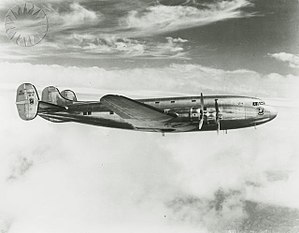Douglas DC-4E
| DC-4E | |
|---|---|
 |
|
| The Douglas DC-4E in flight | |
| Role | Experimental airliner |
| Manufacturer | Douglas Aircraft Company |
| First flight | June 7, 1938 |
| Primary users |
United Airlines Imperial Japanese Airways |
| Number built | 1 |
| Developed into |
Douglas DC-4 Nakajima G5N |
The Douglas DC-4E was an American experimental airliner that was developed before World War II. The DC-4E never entered production, but its failure resulted in an entirely new design, the DC-4/C-54, which proved very successful. Many DC-4E design features found their way into the Japanese Nakajima G5N bomber.
The design originated in 1935 from a requirement by United Air Lines. The goal was to develop a much larger and more sophisticated replacement for the DC-3 before the first DC-3 had even flown. There was enough interest from other airlines that American Airlines, Eastern Air Lines, Pan American Airways and Transcontinental and Western Air (TWA) joined United, providing $100,000 each toward the cost of developing the new aircraft. As cost and complexity rose, Pan American and TWA withdrew their funds in favor of the Boeing 307, which was anticipated to be less costly.
With a planned day capacity of 42 passengers (13 rows of two or more seats and a central aisle) or 30 as a sleeper transport (like the DST), the DC-4 (as it was then known) would seat twice as many people as the DC-3 and would be the first large aircraft with a nosewheel. Other innovations included auxiliary power units, power-boosted flight controls, alternating current electrical system and air conditioning. Cabin pressurization was also planned for production aircraft. The novel tail with three low vertical stabilizers enabled use of existing hangars and provided sufficient vertical fin area to allow the aircraft to take off with only two engines on one side operating. The wing planform was similar to the DC-3, with a swept leading edge and almost straight trailing edge. The four 1,450 hp (1,080 kW) Pratt & Whitney R-2180-A Twin Hornet 14-cylinder radials were all mounted with noticeable toe-out, particularly the outer pair.
...
Wikipedia
